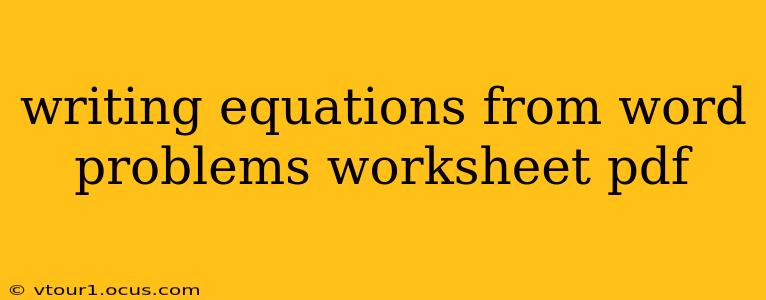Many students find translating word problems into mathematical equations challenging. This guide will break down the process, providing strategies and examples to help you confidently tackle these problems. Mastering this skill is crucial for success in algebra and beyond.
Understanding the Language of Word Problems
The first step is to understand the vocabulary used in word problems. Certain words indicate specific mathematical operations:
- Addition: sum, total, increased by, more than, added to
- Subtraction: difference, decreased by, less than, subtracted from, minus
- Multiplication: product, times, multiplied by, of
- Division: quotient, divided by, per, ratio
Let's illustrate this with some examples:
- "The sum of x and 5 is 12" translates to: x + 5 = 12
- "Seven less than y is 20" translates to: y - 7 = 20 (Notice the order!)
- "The product of 3 and z is 27" translates to: 3z = 27
- "The quotient of a number (n) and 4 is 9" translates to: n/4 = 9
Strategies for Writing Equations
Here's a step-by-step approach to writing equations from word problems:
-
Read Carefully: Read the problem thoroughly, identifying all the given information and what you need to find.
-
Identify Keywords: Look for keywords that suggest mathematical operations (as listed above).
-
Assign Variables: Choose variables to represent the unknown quantities (e.g., x, y, z, n). Clearly define what each variable represents.
-
Translate into an Equation: Translate the words into a mathematical equation, using the keywords and variables.
-
Solve the Equation: Use appropriate algebraic techniques to solve for the unknown variable(s).
-
Check Your Answer: Substitute your solution back into the original word problem to ensure it makes sense and satisfies the conditions given.
Common Types of Word Problems & Examples
Let's examine some common types of word problems and how to translate them into equations:
1. Age Problems
Problem: Sarah is 5 years older than her brother, Tom. The sum of their ages is 27. How old is each person?
Solution:
- Let x = Tom's age
- Sarah's age = x + 5
- Equation: x + (x + 5) = 27
- Solving: 2x + 5 = 27 => 2x = 22 => x = 11 (Tom's age)
- Sarah's age = 11 + 5 = 16
2. Distance Problems
Problem: A train travels at a speed of 60 mph for 3 hours. How far did it travel?
Solution:
- Distance = Speed x Time
- Equation: Distance = 60 mph * 3 hours
- Distance = 180 miles
3. Percent Problems
Problem: A shirt costs $25. It's on sale for 20% off. What is the sale price?
Solution:
- Discount = 20% of $25 = 0.20 * $25 = $5
- Sale price = Original price - Discount
- Equation: Sale price = $25 - $5 = $20
4. Geometry Problems
Problem: The perimeter of a rectangle is 30 cm. The length is 2 cm more than the width. Find the length and width.
Solution:
- Let w = width
- Length = w + 2
- Perimeter = 2(length + width)
- Equation: 2(w + (w + 2)) = 30
- Solving: 4w + 4 = 30 => 4w = 26 => w = 6.5 cm (width)
- Length = 6.5 + 2 = 8.5 cm
Frequently Asked Questions (FAQs)
How do I deal with "less than" or "more than" in word problems?
Be careful with the order! "5 less than x" means x - 5, not 5 - x. "3 more than y" means y + 3, not 3 + y.
What if the word problem uses more than one operation?
Break it down step by step. Identify each operation and translate it into the equation piece by piece.
What are some common mistakes to avoid?
- Misinterpreting keywords.
- Incorrectly assigning variables.
- Not checking your answer.
- Not understanding the context of the problem.
By following these strategies and practicing regularly, you'll develop the skills needed to confidently translate word problems into equations and find the solutions. Remember, practice makes perfect!
